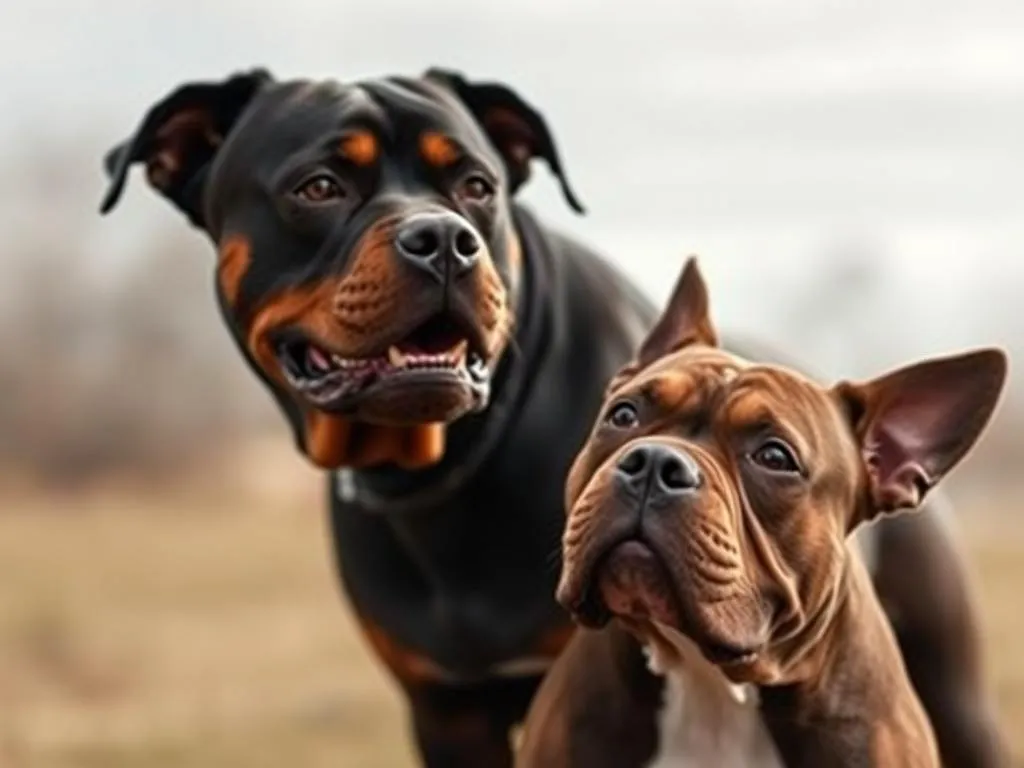
Understanding dog breeds is essential for potential dog owners, as each breed has unique characteristics, histories, and needs. Among the many dog breeds, the Rottweiler and the Pit Bull stand out for their popularity, strong builds, and loyal temperaments. Both breeds have devoted followings, but they also have distinct differences that can influence a potential owner’s decision. Let’s delve into a comprehensive comparison of these two breeds, examining their histories, physical characteristics, temperaments, training needs, health considerations, exercise requirements, and ideal ownership situations.
History of Rottweilers and Pit Bulls
Rottweiler History
The Rottweiler has its origins in Germany, specifically from the town of Rottweil. This breed was initially developed as a herding and guard dog, tasked with protecting livestock and property. Rottweilers were known for their strength and endurance, which made them ideal companions for farmers and merchants. Over time, their reputation grew, and they evolved into versatile working dogs used in various roles, including police and military service. Unfortunately, the Rottweiler has faced some stigma in modern times, often being mischaracterized as aggressive. However, with proper training and socialization, Rottweilers can be gentle and loving family pets.
Pit Bull History
The Pit Bull has a rich history that dates back to the UK, where it was originally bred for bull-baiting. This cruel sport involved setting dogs against bulls, and the breed was developed for strength and tenacity. After bull-baiting was outlawed, Pit Bulls transitioned to the United States, where they became beloved family companions and farm dogs. Despite their affectionate nature, Pit Bulls have been unfairly stigmatized due to their historical use in dog fighting and media portrayals. Today, many advocates work to change misconceptions and promote their positive traits, such as loyalty and friendliness.
Physical Characteristics
Rottweiler Appearance
Rottweilers are large, powerful dogs with a strong build. Adult males typically weigh between 95-135 pounds, while females range from 80-100 pounds. They have a short, dense coat that is predominantly black with distinct tan markings on their cheeks, chest, and legs. Their muscular physique and broad heads give them a commanding presence, making them both impressive and intimidating. Rottweilers are known for their distinctive build, with a broad skull and a strong jaw that reflects their heritage as working dogs.
Pit Bull Appearance
Pit Bulls are medium-sized dogs with a well-defined muscular build. They generally weigh between 30-65 pounds, depending on the specific type of Pit Bull. Their coat is short and can come in various colors, including brindle, fawn, and black. One of the most notable features of Pit Bulls is their broad, blocky heads and strong jaws, which contribute to their powerful appearance. While they may not be as large as Rottweilers, Pit Bulls are incredibly strong for their size and have an athletic build that makes them agile and energetic.
Temperament and Behavior
Rottweiler Temperament
Rottweilers are known for their loyalty, protectiveness, and intelligence. They are naturally confident dogs that often exhibit strong guarding instincts, making them excellent watchdogs. However, their temperament can vary significantly based on socialization and training. Rottweilers require early socialization to develop into well-rounded pets and to reduce any potential aggressive tendencies. They are generally good with families and can be gentle and affectionate with children, though supervision is advised due to their strength.
Pit Bull Temperament
Pit Bulls are often characterized by their friendliness and high energy levels. They are known to be affectionate, loyal, and eager to please, making them excellent family dogs. Pit Bulls tend to be good with children and can thrive in family environments. However, like Rottweilers, they require proper socialization from an early age to ensure they develop into well-adjusted pets. With appropriate training and positive reinforcement, Pit Bulls can be great companions and social dogs, enjoying playtime with both humans and other pets.
Training and Intelligence
Rottweiler Training
Rottweilers are highly intelligent and eager to learn, which makes them relatively easy to train. They respond well to consistent, positive reinforcement training methods. Basic obedience training and early socialization are essential for this breed, as they need to understand their place within the family structure. Rottweilers can sometimes exhibit stubbornness, so patience and persistence are crucial. Common behavioral challenges include dominance issues and territorial behavior, which can be mitigated through proper training and socialization.
Pit Bull Training
Pit Bulls are also intelligent and trainable, often excelling in obedience classes and dog sports. They thrive on positive reinforcement and enjoy engaging activities that mentally stimulate them. Socialization is key to ensuring that Pit Bulls develop good manners and can interact well with other animals and people. While they are generally eager to please, some Pit Bulls may display a strong prey drive, making socialization and control important aspects of their training. Addressing any behavioral challenges early on can lead to a well-behaved companion.
Health Considerations
Common Health Issues in Rottweilers
Rottweilers are prone to certain genetic conditions, including hip and elbow dysplasia, heart issues, and certain types of cancer. Their lifespan typically ranges from 8 to 10 years. Regular veterinary check-ups, a balanced diet, and proper exercise can help manage their overall health. Preventive measures, such as routine vaccinations and parasite control, are essential for maintaining a healthy Rottweiler. Additionally, responsible breeding practices can significantly reduce the risk of hereditary health issues.
Common Health Issues in Pit Bulls
Pit Bulls can also face health challenges, including hip dysplasia, skin allergies, and certain genetic conditions. Their lifespan is generally between 12 to 16 years, which is relatively long compared to some larger breeds. Regular veterinary visits, a nutritious diet, and appropriate exercise can contribute to their overall well-being. Just like Rottweilers, responsible breeding can help minimize health issues and ensure that Pit Bulls are healthy and happy throughout their lives.
Lifestyle and Exercise Needs
Rottweiler Exercise Requirements
Rottweilers are active dogs that require regular exercise to stay healthy and happy. Daily exercise recommendations typically include at least 1 to 2 hours of physical activity. Suitable activities include walking, running, and engaging in playtime. Rottweilers also benefit from mental stimulation, which can be provided through training sessions, puzzle toys, and interactive games. A lack of exercise can lead to boredom and potential behavioral issues, so it’s important to keep them engaged.
Pit Bull Exercise Requirements
Pit Bulls are energetic and require significant exercise to maintain their physical and mental health. Daily exercise recommendations usually include at least 1 hour of vigorous activity. Activities such as agility training, fetch, and structured playtime are excellent for this breed. Mental stimulation is equally important; Pit Bulls enjoy engaging in training sessions and interactive games that challenge their intelligence. Regular exercise helps prevent boredom and promotes a well-adjusted and happy pet.
Suitability for Different Owners
Ideal Owners for Rottweilers
Rottweilers are best suited for active families or individuals who have experience with dog ownership. Their protective nature makes them excellent companions for those who can provide firm, consistent training and socialization. A house with a yard is typically more suitable for Rottweilers, as they require space to exercise. Owners should be prepared for a time commitment related to training and physical activity, ensuring that this strong, intelligent breed receives the attention it needs.
Ideal Owners for Pit Bulls
Pit Bulls can adapt well to various living environments, including apartments, provided they receive adequate exercise. They are suitable for active families and first-time dog owners, as long as the owners are willing to invest time in training and socialization. Pit Bulls thrive on human interaction and enjoy being part of family activities. Potential owners should be prepared for a commitment to daily exercise and mental stimulation to keep their Pit Bull happy and healthy.
Rottweiler vs Pit Bull: Key Differences
In comparing Rottweiler vs Pit Bull, several key differences emerge:
- History: Rottweilers were bred primarily as working dogs in Germany, while Pit Bulls have a history linked to bull-baiting in the UK.
- Appearance: Rottweilers are larger and more robust, while Pit Bulls are medium-sized with a muscular build.
- Temperament: Rottweilers are known for their protectiveness, while Pit Bulls are characterized by their friendliness and eagerness to please.
- Training: Both breeds are intelligent and trainable, but Rottweilers may exhibit more stubbornness compared to the eager-to-please nature of Pit Bulls.
- Health: Both breeds face specific health challenges; Rottweilers tend to have a shorter lifespan than Pit Bulls.
- Exercise Needs: Both breeds require regular exercise, but Pit Bulls often have higher energy levels and may need more vigorous activities.
Personal anecdotes from owners of each breed reveal that while both can be loving companions, the choice between a Rottweiler vs Pit Bull often comes down to individual lifestyle, preferences, and the kind of engagement potential owners are prepared to offer.
Conclusion
When considering a dog, it’s essential to take into account the unique characteristics and needs of each breed. The Rottweiler and Pit Bull both offer loyalty, strength, and companionship, but they do so in different ways. Rottweilers may appeal to those seeking a protective guardian, while Pit Bulls often enchant families with their affectionate and playful nature. Ultimately, the decision should reflect one’s lifestyle, living situation, and commitment to training and socialization. Each dog brings its own set of joys and challenges, making it crucial to choose a breed that aligns with your personal circumstances and preferences.









